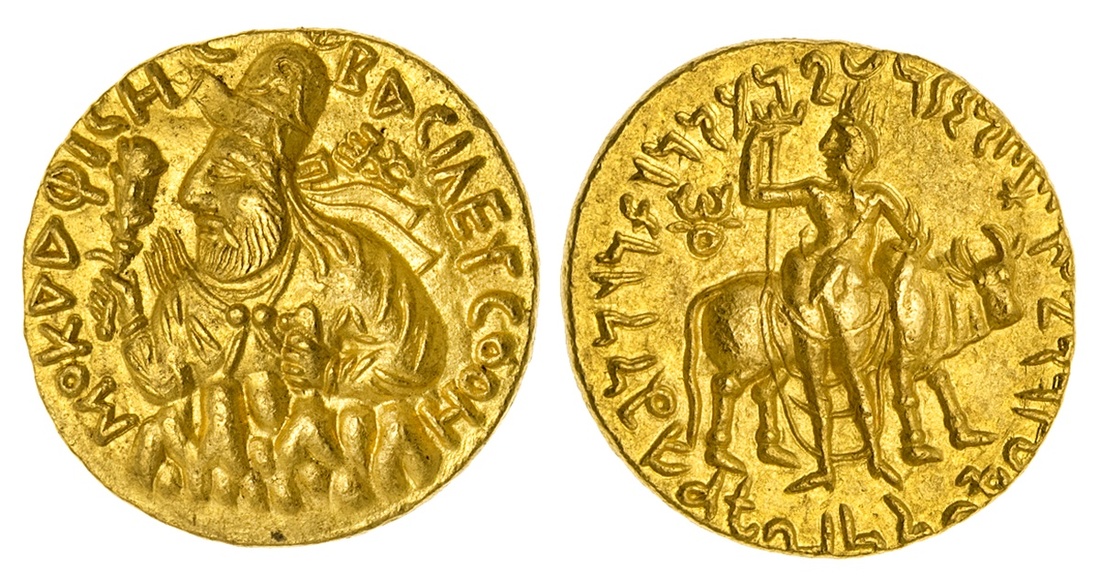S 1655 - Begram ? (Vima Kadphises), gold, double dinars (113-128 CE)
From SILVER
113 CE - 128 CE Gold 19,048 kg
Description
| ObverseInscription or printing placed on the obverse.: | ΒΑΣΙΛΕΥΣ ΟΟΗ-ΜΟ ΚΑΔΦΙΣΗΣ (Greek).Bearded bust of the king left, emerging from mountain top, wearing a tall round cap with upturned peak, surmounted by small crescents, diadem ribbons behind, flames on his right shoulder, wearing an open robe with double clasp, holding a knobbed club in raised right hand and clasping the curved hilt of a sword in left hand, tamgha in right field |
| ReverseInscription or printing placed on the reverse.: | Kharoshthi legend around: maharajasa rajadirajasa sarvaloga'i?varasa mahi?varasa v'ima kathpi?asa tradara (of great king, king of kings, lord of the world, great lord, Wima Kadphises, saviour) (Karosthi).Oesho standing facing, head left, ithyphallic and naked except for a diaphanous garment, amulet string across chest, holding trident and animal skin, Nandi the bull behind, nandipada symbol in left field, |
Mint and issuing power
| MintIdentifies the place of manufacture or issue of a numismatic object.: | Begram | Ancient regionAncient region.: | Bactria | Modern countryModern country: Afghanistan | AuthorityIdentifies the issuing power. The authority can be "pretended" when the name or the portrait of X is on the coin but he/she was not the issuing power. It can also be "uncertain" when there is no mention of X on the coin but he/she was the issuing power according to the historical sources: | Vima Kadphises |
Chronology
| FromIdentifies the initial date in a range assigned in a numismatic context. | 113 CE | toIdentifies the final date in a range assigned in a numismatic context.. | 128 CE | PeriodTime period of the numismatic object.: Roman from 30 BC |
Physical description
| MetalThe physical material (usually metal) from which an object is made.: | Gold |
Median weightMedian of the weights of numismatic objects (in grams). in grams | 15.90 | DenominationTerm indicating the value of a numismatic object. Examples: tetradrachm, chalkous, denarius.: | double dinar, double stater | StandardStandard.: |
Image

S1655 Vima Kadphises double staters.jpg [1]
References
| Die study referencePublication of the study: | Bracey 20091Bracey 2009 | ||
| Coin series referenceReference to coin series study: | |||
Obverse dies distribution
no distribution is available
Reverse dies distribution
no distribution is available
Quantification
| Number of obversesNumber of obverse dies. ᵖ (o) | 6 | Number of singletons (o1)The number of singleton coins. ᵖ | |
| Number of reverse diesNumber of reverse dies. (r) | 39 | Number of coinsNumber of coins. (n) | 76 |
| Coins per obverse dieNumber of coins per obverse die. (n/o) | 12.67 | Coins per reverse dieNumber of coins per reverse die. (n/r) | 1.95 |
| Reverse per obverse ratioRatio of obverse dies divided by reverse dies. (r/o) | 6.5 | Percentage of singletons (o1)number of coins (n) divided by the number of singletons (o1) ᵖ | % |
| Original number of dies (O) (Carter 1983 formula)The estimation of the number of coins according to Carter 1983 ᵖ | 5.99 | Coins struck if 20,000 as average productivity per dieCoins made if the average productivity for obverses (according to Carter) is 20,000. ᵖ | 119,800 |
| Original number of dies (O) (Esty 2011 formula)The estimation of the number of coins according to the singleton formula in Esty 2011 ᵖ (O) | 6.51 | Survival rate if 20,000 as average productivity per dieSurvival rate if average productivity is 20,000. ᵖ | 0.00063 |
| Coverage (o = % of O) (Esty 1984 formula)Esty 1984 - coverage (% of O) ᵖ (o = % of O) | % | Die productivity if survival rate 1/2,000Average productivity if survival rate is 1/2,000. ᵖ | 25,375.63 |
| Weight of silver (in kg) if 20,000 coins per die (O = Carter formula)Carter 1983 * Median weight * 20000 (*10 if gold or electrum) ᵖ | 19,048 kg <br /> 19,048 kg | Die productivity if survival rate 1/5,000Average productivity if survival rate is 1/5,000. ᵖ | 63,439.07 |
Remarks
Most likely more than 2 workstations